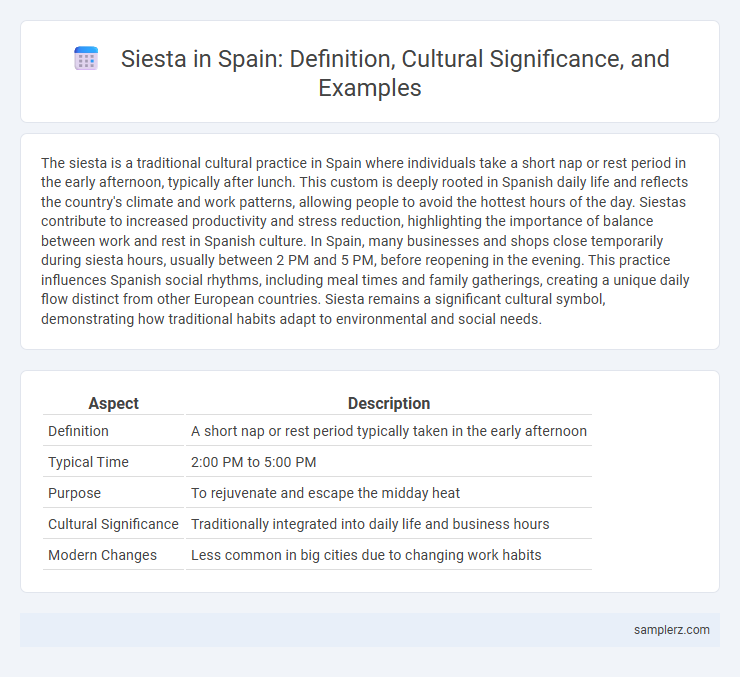The siesta is a traditional cultural practice in Spain where individuals take a short nap or rest period in the early afternoon, typically after lunch. This custom is deeply rooted in Spanish daily life and reflects the country's climate and work patterns, allowing people to avoid the hottest hours of the day. Siestas contribute to increased productivity and stress reduction, highlighting the importance of balance between work and rest in Spanish culture. In Spain, many businesses and shops close temporarily during siesta hours, usually between 2 PM and 5 PM, before reopening in the evening. This practice influences Spanish social rhythms, including meal times and family gatherings, creating a unique daily flow distinct from other European countries. Siesta remains a significant cultural symbol, demonstrating how traditional habits adapt to environmental and social needs.
Table of Comparison
| Region | Typical Siesta Time | Duration | Activities | Cultural Significance |
|---|---|---|---|---|
| Andalusia | 2:00 PM - 5:00 PM | 1.5 - 3 hours | Rest, family time, naps | Helps avoid the hottest hours, promotes family bonding |
| Madrid | 3:00 PM - 4:30 PM | 1 - 1.5 hours | Short nap, light meals | Balances work and rest, maintains productivity |
| Catalonia | 2:30 PM - 4:00 PM | 1 - 1.5 hours | Rest, socializing in cafes later | Offers relaxation and social opportunities |
| Valencia | 1:30 PM - 3:30 PM | 1 - 2 hours | Napping, family meals | Customary pause for refreshment and rest |
Historical Origins of the Siesta in Spain
The siesta in Spain originated from ancient Roman and Mediterranean rest customs, where midday breaks helped laborers avoid the hottest hours. Historical records trace siesta practices back to agricultural societies dependent on siestas to enhance productivity and health in extreme heat. This tradition evolved into a cultural institution reflecting Spain's adaptation to its climate and social rhythms.
The Traditional Siesta: Daily Schedule and Routine
The traditional siesta in Spain typically occurs between 2 p.m. and 5 p.m., a period when businesses close and many residents rest to avoid the afternoon heat. This routine involves a light lunch followed by a short nap or relaxation, enhancing productivity and well-being in the later hours. Despite modernization, the siesta remains a cultural hallmark in many regions, reflecting Spain's historical adaptation to its climate and social rhythms.
Regional Variations of Siesta Practices in Spain
Siesta practices in Spain vary significantly across regions, reflecting local climates and cultural traditions. In southern areas like Andalusia, longer midday breaks are common due to intense heat, whereas northern regions such as Catalonia often have shorter or no siesta periods. Urban centers like Madrid show a decline in siesta habits as modern work schedules and globalization influence daily routines.
Contemporary Attitudes Toward the Siesta
The traditional siesta in Spain, once an integral part of daily life, has seen a decline in contemporary urban settings due to changing work patterns and globalization. Many Spanish cities now experience reduced midday breaks as businesses prioritize continuous operating hours to align with international markets. However, in smaller towns and rural areas, the siesta remains a cherished cultural practice reflecting a balance between work and rest.
Siesta and Spanish Work-Life Balance
Siesta, a traditional midday break in Spain, reflects the country's unique approach to work-life balance by allowing workers to rest and recharge during peak afternoon hours. This cultural practice supports productivity and well-being by splitting the workday into two segments, typically with a pause from 2 PM to 5 PM. Despite modernization and changing work patterns, siesta remains a symbol of Spanish lifestyle, emphasizing the importance of downtime in maintaining mental health and family cohesion.
Famous Spanish Cities Embracing the Siesta
Madrid and Seville, two of Spain's most famous cities, strongly embrace the tradition of the siesta, with businesses and shops closing in the early afternoon to allow residents a midday rest. This cultural practice enhances daily productivity and promotes well-being by aligning work schedules with natural energy dips. The siesta in these cities reflects deep-rooted customs that continue to influence modern urban life in Spain.
Siesta Culture: Impact on Local Businesses
Siesta culture in Spain significantly influences local businesses by altering traditional working hours, with many shops and offices closing during the early afternoon for a two-hour break. This practice reduces operational hours but increases employee productivity and customer engagement during extended evening hours. The siesta fosters a unique economic rhythm, shaping business strategies and consumer behavior throughout Spanish communities.
How the Siesta Influences Social Life in Spain
The siesta in Spain deeply influences social life by fostering stronger family bonds and community interactions during midday breaks, as businesses close and people gather for meals and rest. This tradition enhances work-life balance, promoting social cohesion through relaxed, shared experiences that differ from the fast-paced rhythms of other cultures. The practice also supports local economies tied to traditional dining and social venues that thrive during siesta hours.
Health Benefits Associated with the Spanish Siesta
The traditional Spanish siesta, a short afternoon nap lasting 20-30 minutes, significantly improves cardiovascular health by reducing stress and lowering blood pressure. Research indicates that regular siestas can enhance cognitive function, boost mood, and decrease the risk of heart attacks. Integrating this cultural practice into daily routines promotes overall well-being and supports mental resilience.
The Future of Siesta in Modern Spanish Society
The future of siesta in modern Spanish society faces challenges due to urbanization and globalized work demands, leading to a gradual reduction in traditional midday breaks. Despite this shift, efforts to preserve siesta culture emphasize its benefits for productivity and health, supported by emerging flexible work policies. Studies show that countries integrating siesta-like pauses experience improved workplace efficiency and employee well-being, suggesting potential adaptations for Spain's evolving lifestyle.

example of siesta in Spain Infographic
 samplerz.com
samplerz.com